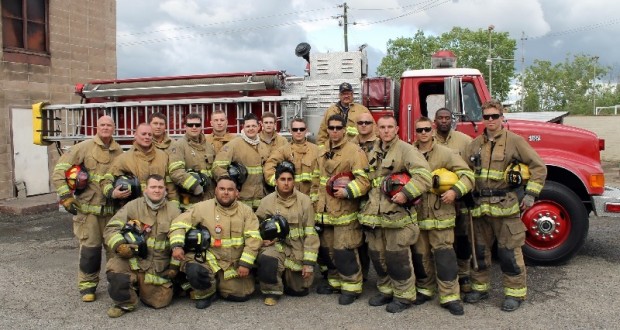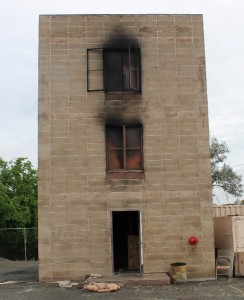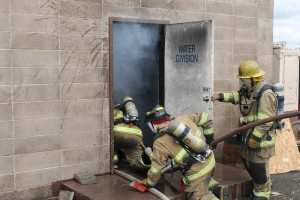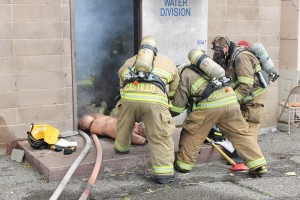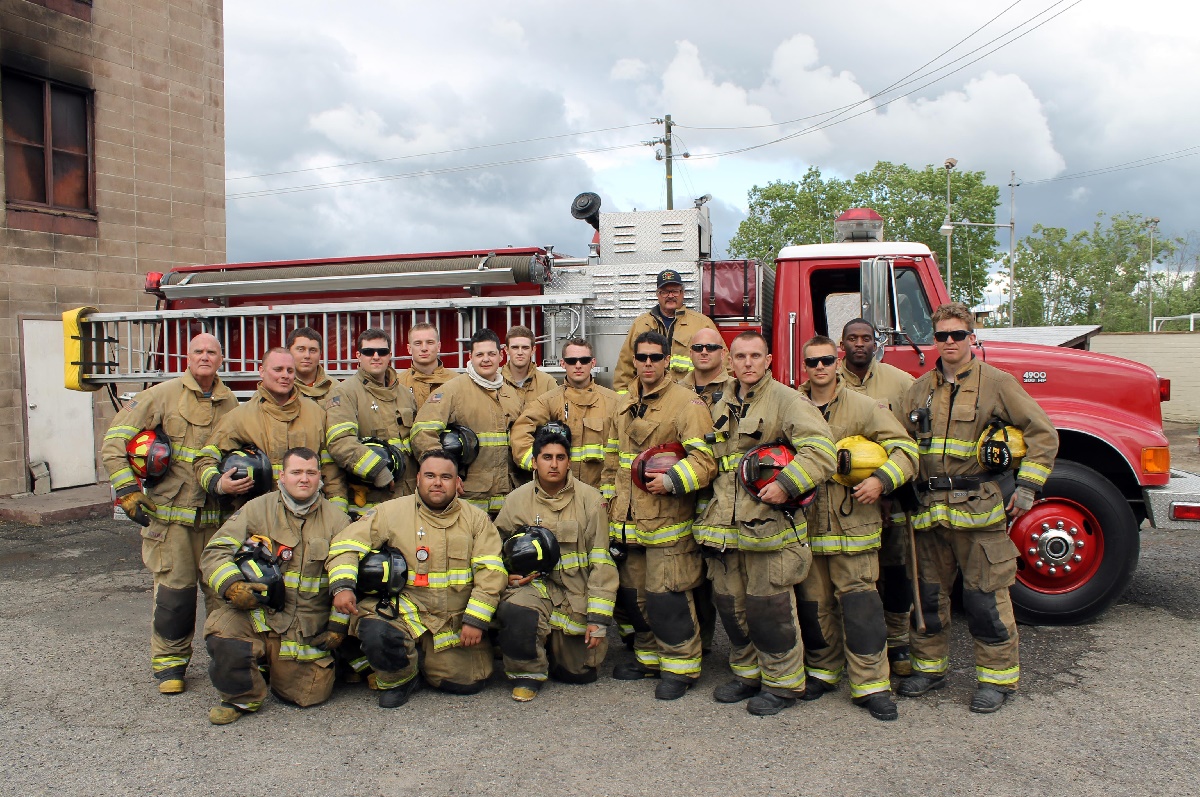Written by Bill Ritchey —
“Structure Day” — It had been an intense 200 hours, spread over the last three months for twelve recruits of Madera County Fire Department’s (MCFD) Basic Skills Academy for Paid Call Firefighters (PCFs).
On April 10, the recruits gathered at Madera City Fire Station 6, where they would undergo their last training drill, simply called “Structure Day.” A few days later, they would take their final written examination and hopefully graduate, marking their entry into service as Madera County PCFs.
Station 6 is the site of a 50-year-old, 3-story training tower. Constructed out of concrete block, there are stairwells and room-sized concrete landings on the 2nd and 3rd floor.
This tower would serve as the “master prop” for the day’s training. Inside, the recruits would face demonstrations of fire behavior in a confined space, where the academy staff carefully ignited small amounts of hay and wood scraps, creating dense smoke and rolling fire.
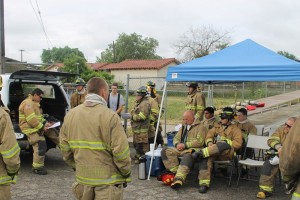
Morning briefing of PCF recruit academy class conducted by Fire Captain Anthony Garcia – photo by Bill Ritchey
Later in the day, the recruits would enter the smoking tower to conduct simulated search and rescue operations.
The day began with the now-familiar briefing process conducted by Fire Captain (CPT) Anthony Garcia — MCFD Training Captain and Academy principal instructor. CPT Garcia briefs the recruits from a written document, the “Incident Action Plan.” IAPs are the “bible” on any major incident they will respond to as firefighters.
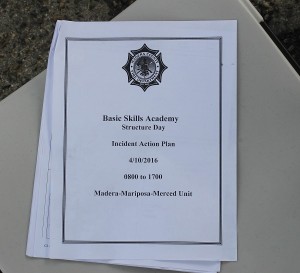 The carefully crafted document spells out the training scenarios and goals, delineates roles and responsibilities of staff, itemizes what equipment and resources are to be used, and addresses emergency contingencies — in other words, the rescue plan should things go awry.
The carefully crafted document spells out the training scenarios and goals, delineates roles and responsibilities of staff, itemizes what equipment and resources are to be used, and addresses emergency contingencies — in other words, the rescue plan should things go awry.
As the recruits listened intently, Garcia ordered them to, “Move with purpose,” cautioning them that they will make mistakes this day, as well as in the future — their careers will be a lifelong learning process.
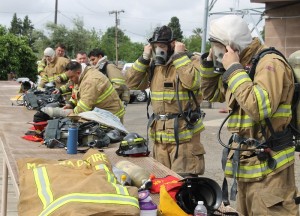
PCF recruits donning their personal protective equipment, including self-contained breathing apparatus for Structure Day – photo by Bill Ritchey
The academy staff sized up the recruits as they prepped and donned their personal protective equipment.
One recruit was stopped in his tracks from proceeding — he was not clean-shaven and was ordered to shave before continuing his training day. There can be no impediment to proper sealing of the self-contained breathing apparatus mask.
Ready or not, the recruits’ day had begun.
The Rescue
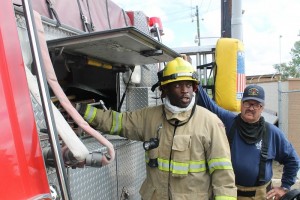
Veteran PCFs Tamu Green and Paul Shafer provide support to PCF recruits with Engine 219 for their simulated structure fire response
After the morning demonstrations in the tower, the recruits began their simulated response and rescue. Assisting MCFD/Cal Fire academy staff were veteran PCFs Paul Shafer of Station 19, and Tamu Green from Station 1.
Shafer and Green buddied the recruits in teams of two, as they “responded” in Engine 219 to the “structure fire” in the training tower.
Upon arrival, the two-recruit team pulled a charged hose, donned their breathing apparatus, and entered the burning structure observing the “two in, two out” rule.
This rule was enacted by the Occupational Safety and Health Administration in 1998, and requires two firefighters be stationed outside the structure in addition to the two firefighters making entry.
The two additional firefighters — the Rapid Intervention Crew (RIC) — are available to initiate a firefighter rescue should the first two become trapped.
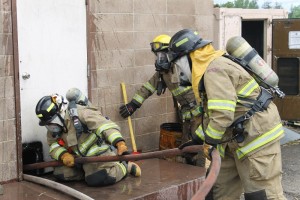
Two firefighter Rapid Intervention Crew provides back-up outside, with two inside for fire attack and rescue – photo by Bill Ritchey
Leaving nothing to chance during the rescue drills, MCFD/Cal Fire staff remained in the tower supervising the recruits, with a second charged hose line as back-up.
All afternoon, teams of two entered the tower filled with fire and smoke, conducted a search, pulled a “victim” (a weighted, life-size mannequin) down the stairs to safety, with an RIC waiting at the entry.
The physical demands placed on the recruits were great. Wearing the weighted protective suits and breathing apparatus, moving the hose line, crawling up stairs, and bringing the victim out brought the recruits to the point of near total exhaustion.
Station 8 recruit, sweat-drenched Dakota Medovitch, put into words the physical and logistical challenges of the exercise.
“The heat was intense, and fire was climbing up the wall. There was no visibility going up the stairs because of the smoke, and we felt our way doing a search pattern.”
Roof Operations — A Risky Proposition
Modern day wooden trusses are a standard of current construction methods; but when a building of such design is struck by fire, it rapidly weakens and can collapse. Roof collapse is a “widow maker” to the fire service, as nearly occurred in March, 2015, when Fresno City Fire Captain Pete Dern fell through the roof into the inferno of a raging garage fire.
Dern narrowly escaped death while sustaining extensive third degree burns. His survival is a testament not only to the effectiveness of his modern protective clothing and breathing apparatus, but an adequate number of firefighters at scene to effect a quick rescue.
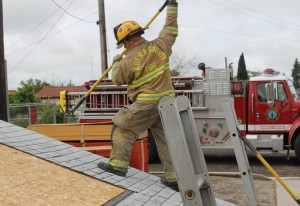
Cal Fire Firefighter Nick Sciaqua (Bass Lake Station) “sounds” a roof, checking for strength and safety
Charged with the responsibility of teaching the recruits safe roof operations were MCFD Engineer Adam Kernaghan and Cal Fire firefighter Nick Sciaqua.
Using props of framed pitched roofs, PCFs observed demonstrations and participated in hands-on practice assessing the stability of roofs by “sounding” with hand tools — a process of striking the roof to check for strong points and signs of weakness.
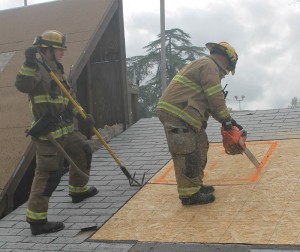
MCFD Engineer Adam Kernaghan (Station 3) (left) assists Firefighter Nick Sciaqua with roof ventilation demonstration – photo by Bill Ritchey
Kernaghan and Sciaqua also demonstrated roof ventilation techniques utilizing chain saws and axes.
Roof ventilation is performed to aid in the dissipation of smoke and heat from a burning structure, assisting in efforts to bring the fire under control.
Before the day ended, all PCFs participated in supervised roof sounding, and the strenuous task of cutting ventilation openings with axes; again while wearing full protective gear and breathing apparatus.
From Graduation to Deployment
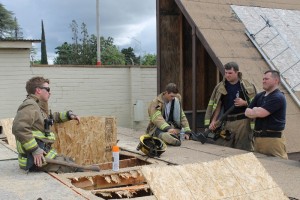
Engineer Kernaghan and PCFs Morgan Mayer, Nathan Henson, and Christopher Taylor take a well deserved break after roof ventilation performed with axes – photo by Bill Ritchey
After a physically and mentally demanding nine-hour day, relief and reward could be seen on the faces of Madera County’s newest Paid Call Firefighters. Following a well-deserved respite, they assembled on the training ground for a class photo with their academy staff.
After their final exam on April 13, the PCFs were released to their stations to complete final skills checklists and orientation, prior to being placed into full service.
To be sure, as a new fire season is upon us, every new PCF’s skills and service will be put to test, doing their best to protect and serve the citizens of Madera County.
Madera County PCF Class photo: (kneeling, left to right) PCFs John Clark (Co. 12), Frank Castillo (Co. 19), Sukhvir Singh (Co. 1); (standing, left to right) PCF Roy Broomfield (Co. 12), Josh Orcutt (Co. 19), Dakota Medovitch (Co. 8), Nathan Henson (Co. 19), Seth Wedemyer (Co.19), Christopher Taylor (Co. 12), Morgan Mayer (Co. 19), Randall Purday (Co. 8). Instructors Fire Captain Anthony Garcia (MCFD Training Officer), Firefighter Nick Sciaqua (Bass Lake CAL FIRE), Fire Captain Vance Killion (Stn. 3), Firefighter Travis Bonds (Stn. 8)), PCF Tamu Green (Stn. 1), Fire Apparatus Engineer Adam Kernaghan (Stn. 3); third row, Instructor PCF Paul Shafer (Co. 19). Not shown, PCF Jack Fulcher (Co. 10).
This article is the third in a series describing recruitment, training, and deployment of Madera County Paid Call Firefighters.
Editor’s note: This series and others from Bill Ritchey will be exploring the challenges, current conditions and potential solutions to the issues facing the Madera County Fire Department. Bill is a resident of Raymond. With a Masters of Science degree in Nurse Anesthesia, he has been an anesthesia provider for 21 years, and has worked extensively providing trauma and critical care anesthesia at the regional trauma center in Fresno. He is very involved in advocacy for local emergency services, and helped formulate policy for pre-hospital advanced life support by ambulance personnel and fire department first responders in Madera County. He also served as a first responder trainer for Madera City and County Fire Departments.
The Making Of A Paid Call Firefighter Pt. 2 — The Training
The Making Of A Paid Call Firefighter Pt. 1 – Local Heroes In Decline
What is an Amador Cal Fire Station?
Madera County Quietly Loses A Fire Station

